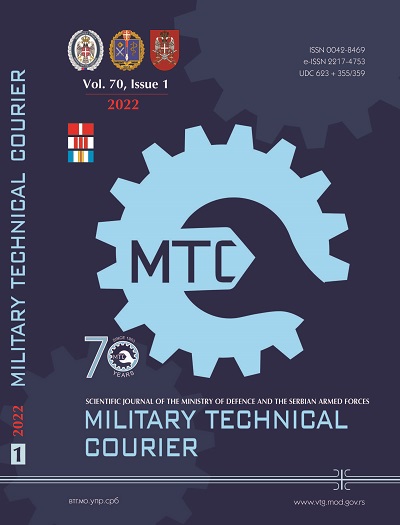Application of probability-based multi–objective optimization in material engineering
Abstract
Introduction/purpose: Althought many methods have been proposed to deal with the problem of material selection, there are inherent defects of additive algorithms and subjective factors in such methods. Recently, a probability-based multi–objective optimization was developed to solve the inherent shortcomings of the previous methods, which introduces a novel concept of preferable probability to reflect the preference degree of the candidate in the optimization. In this paper, the new method is utilized to conduct an optimal scheme of the switching material of the RF-MEMS shunt capacitive switch, the sintering parameters of natural hydroxyapatite and the optimal design of the connecting claw jig.
Methods: All performance utility indicators of candidate materials are divided into two groups, i.e., beneficial or unbeneficial types for the selection process; each performance utility indicator contributes quantitatively to a partial preferable probability and the product of all partial preferable probabilities makes the total preferable probability of a candidate, which transfers a multi–objective optimization problem into a single–objective optimization one and represents a uniquely decisive index in the competitive selection process.
Results: Cu is the appropriate material in the material selection for RF - MEMS shunt capacitive switches; the optimal sintering parameters of natural hydroxyapatite are at 1100°C and 0 compaction pressure; and the optimal scheme is scheme No 1 for the optimal design of a connecting claw jig.
Conclusion: The probability-based multi-objective optimization can be easily used to deal with an optimal problem objectively in material engineering.
References
Abifarin, J.K. 2021 Taguchi grey relational analysis on the mechanical properties of natural hydroxyapatite: effect of sintering parameters. The International Journal of Advanced Manufacturing Technology, 117, pp.49-57. Available at: https://doi.org/10.1007/s00170-021-07288-9
Angira, M. & Rangra, K. 2015a. Design and investigation of a low insertion loss, broadband, enhanced self and hold down power RF-MEMS switch. Microsystem Technologies, 21(6), pp.1173-1178. Available at: https://doi.org/10.1007/s00542-014-2188-6
Angira, M. & Rangra, K. 2015b. Performance improvement of RF-MEMS capacitive switch via asymmetric structure design. Microsystem Technologies, 21(7), pp.1447-1452. Available at: https://doi.org/10.1007/s00542-014-2222-8
Ashby, M.F. 2000. Multi-Objective optimization in material design and selection. Acta Materialia, 48(1), pp.359-369. Available at: https://doi.org/10.1016/S1359-6454(99)00304-3
Ashby, M.F., Bréchet, Y.J.M., Cebon, D. & Salvo, L. 2004. Selection strategies for materials and processes. Materials & Design, 25(1), pp.51-67. Available at: https://doi.org/10.1016/S0261-3069(03)00159-6
Deshmukh, D. & Angira, M. 2019. Investigation on Switching Structure Material Selection for RF-MEMS Shunt Capacitive Switches Using Ashby, TOPSIS and VIKOR. Transactions on Electrical and Electronic Materials, 20, pp.181-188. Available at: https://doi.org/10.1007/s42341-018-00094-3
Podviezko, A. & Podvezko, V. 2015. Influence of data transformation on multicriteria evaluation result. Procedia Engineering, 122, pp.151-157. Available at: https://doi.org/10.1016/j.proeng.2015.10.019
Yan, Y., Fu, N., Zhang, X., Wang, C., Sun, J. & Lu, L. 2021. Research on the Multi-Objective Optimization Design of Connecting Claw Jig. International Journal of Steel Structures, 21(6), pp.1911-1920. Available at: https://doi.org/10.1007/s13296-021-00542-6
Yang, W-C., Chon, S-K., Choe, C-M. & Yang, J-Y. 2021. Materials selection method using TOPSIS with some popular normalization methods. Engineering Research Express, 3(1), art.number: 015020. Available at: https://doi.org/10.1088/2631-8695/abd5a7
Zheng, M., Wang, Y. & Teng, H. 2021. A New "Intersection" Method for Multi-Objective Optimization in Material Selection. Tehnički glasnik, 15(4), pp.562-568. Available at: https://doi.org/10.31803/tg-20210901142449
Proposed Creative Commons Copyright Notices
Proposed Policy for Military Technical Courier (Journals That Offer Open Access)
Authors who publish with this journal agree to the following terms:
Authors retain copyright and grant the journal right of first publication with the work simultaneously licensed under a Creative Commons Attribution License that allows others to share the work with an acknowledgement of the work's authorship and initial publication in this journal.
- Authors are able to enter into separate, additional contractual arrangements for the non-exclusive distribution of the journal's published version of the work (e.g., post it to an institutional repository or publish it in a book), with an acknowledgement of its initial publication in this journal.
- Authors are permitted and encouraged to post their work online (e.g., in institutional repositories or on their website) prior to and during the submission process, as it can lead to productive exchanges, as well as earlier and greater citation of published work (See The Effect of Open Access).

